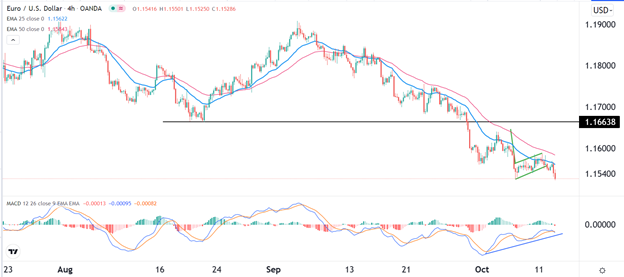The EUR/USD has remained stable under downward pressure around the 1.1550, its lowest support in months. The most popular currency pair in the Forex market is still vulnerable to a bearish market and may fall to 1.1495 if the US inflation data on Wednesday or the content of the minutes of the latests meeting of the US Federal Reserve provide inspiration for the dollar to launch a new attack.
The recent rebound of the currency pair left the 200-week moving average for the EUR/USD at 1.1571 unchanged at the beginning of the week's trading. Meanwhile, last Wednesday's low was accompanied by an early upward reversal extension in the RSI on the charts, indicating an "bullish divergence" that could often serve as a warning that a trend change is occurring by leaps and bounds.
It was precisely this signal that pre-warned a rally from 1.1665 to 1.1910 between late August and early September, and the repetition of this divergence has already made some euro sellers and dollar buyers more cautious about the short-term outlook. This indicates some caution. “We have tightened the stop,” says Karen Jones, head of technical analysis for currencies, commodities and bonds at Commerzbank. "Intraday rallies will find an accelerating downtrend at 1.1659, but major resistance nearby is 1.1777 3-month downtrend.”
Being cautious about the price action of the currency pair over the coming days, the Commerzbank team has been EUR/USD price-sellers in recent weeks and has a 1-3-week bearish outlook that envisions a further slide towards 1.1395. However, they also identified the 1.1495 support as likely to cut any further exchange rate depreciation and others have noted this level as well.
Paul Siana, Chief Technical Analyst at BofA Global Research says, “Our modest downside scenario estimates downside EUR levels at 1.1495, 1.13 and possibly 1.1290. If the decline accelerates, we could see 1.1127, 1.10 and possibly $1.0817.” The perceived drop to 1.1395 and the expected support in this area is in line with BofA Global Research's overall forecast for EURUSD to trade around 1.15 at the end of 2021.
The European Central Bank's calculations last week indicated that the baseline forecast for inflation in 2023 was too low. This means an upward revision in December and a greater likelihood that inflation will be on track at the end of the forecast horizon. This could take the EUR/USD pair out of a gap below the 1.16 support.
Federal Reserve Governor Jerome Powell said after the September meeting that there is broad support from the FOMC for a plan to end the Fed's $120 billion quantitative easing program by the middle of next year. Meanwhile, the bank's forecast plan indicated that a majority in the rate-setting committee also expects to start raising interest rates before the end of next year.
Today the euro will be affected by the announcement of the ZEW German Economic Sentiment Index. The US dollar will be affected by statements from US monetary policy officials.


